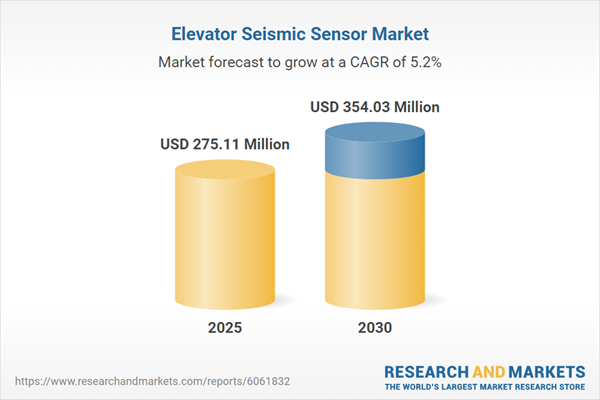The elevator seismic sensor market is projected to grow at a CAGR of 5.17% over the forecast period, increasing from US$275.110 million in 2025 to US$354.025 million by 2030.
The rapid market expansion of elevator seismic sensors stems from an elevated emphasis on safety requirements, technological breakthroughs, and the increasing urban population.
The enforcement of stricter safety standards and improved building codes make seismic sensors an absolute requirement for elevator safety during earthquakes.
The rapid market expansion of elevator seismic sensors stems from an elevated emphasis on safety requirements, technological breakthroughs, and the increasing urban population.
The enforcement of stricter safety standards and improved building codes make seismic sensors an absolute requirement for elevator safety during earthquakes.
Market Trends:
- The integration of elevator seismic sensors is playing a pivotal role in improving building resilience, particularly in regions prone to earthquakes. These sensors ensure safe and reliable elevator operation during and after seismic events, facilitating rapid and secure evacuations, preventing uncontrolled elevator movements, and enabling critical services to remain operational. By supporting emergency response efforts and minimizing business disruptions, seismic sensors contribute significantly to enhancing both safety and operational continuity in buildings.
- A key trend emerging in the industry is the integration of seismic sensors with elevators and smart building technologies. This integration enables real-time monitoring, automated responses, and predictive maintenance, further bolstering building safety and efficiency. By connecting seismic sensors to Building Management Systems (BMS), Internet of Things (IoT) platforms, and emergency response systems, buildings can achieve enhanced safety protocols, improved resilience, and optimized operational performance. This convergence of technologies represents a significant step forward in creating smarter, safer, and more adaptive urban infrastructure.
- The Asia-Pacific region is expected to witness substantial demand for elevator seismic sensors, driven by rapid urbanization and the need for advanced safety measures in high-rise buildings. For instance, India is undergoing a remarkable urban transformation, with its urban population projected to reach 600 million, or 40% of the total population, by 2036, up from 31% in 2011. According to the World Bank Group, urban areas are expected to contribute nearly 70% to the country’s GDP, underscoring the importance of resilient infrastructure to support this growth. As cities expand and urban density increases, the adoption of seismic sensors will be critical to ensuring the safety and sustainability of urban developments.
- In conclusion, the adoption of elevator seismic sensors, coupled with their integration into smart building systems, is transforming the way buildings respond to seismic events. With the Asia-Pacific region leading the demand due to rapid urbanization, this technology is set to play a crucial role in enhancing building resilience, safety, and operational efficiency in the years to come.
Key Benefits of this Report:
- Insightful Analysis: Gain detailed market insights covering major as well as emerging geographical regions, focusing on customer segments, government policies and socio-economic factors, consumer preferences, industry verticals, and other sub-segments.
- Competitive Landscape: Understand the strategic maneuvers employed by key players globally to understand possible market penetration with the correct strategy.
- Market Drivers & Future Trends: Explore the dynamic factors and pivotal market trends and how they will shape future market developments.
- Actionable Recommendations: Utilize the insights to exercise strategic decisions to uncover new business streams and revenues in a dynamic environment.
- Caters to a Wide Audience: Beneficial and cost-effective for startups, research institutions, consultants, SMEs, and large enterprises.
What can businesses use this report for?
Industry and Market Insights, Opportunity Assessment, Product Demand Forecasting, Market Entry Strategy, Geographical Expansion, Capital Investment Decisions, Regulatory Framework & Implications, New Product Development, Competitive Intelligence.Report Coverage:
- Historical data from 2022 to 2024 & forecast data from 2025 to 2030
- Growth Opportunities, Challenges, Supply Chain Outlook, Regulatory Framework, and Trend Analysis
- Competitive Positioning, Strategies, and Market Share Analysis
- Revenue Growth and Forecast Assessment of segments and regions including countries
- Company Profiling (Strategies, Products, Financial Information, and Key Developments among others)
Elevator Seismic Sensor Market is analyzed into the following segments:
By Product Type
- MEMS-based Sensors
- Piezoelectric Sensors
- Accelerometer-based Sensors
By Application
- Residential Buildings
- Commercial Buildings
- Industrial Buildings
- Public Infrastructure
By Geography
- North America
- USA
- Canada
- Mexico
- South America
- Brazil
- Argentina
- Others
- Europe
- Germany
- UK
- France
- Spain
- Others
- Middle East and Africa
- UAE
- Israel
- Others
- Asia Pacific
- China
- Japan
- South Korea
- India
- Indonesia
- Taiwan
- Thailand
- Others
Table of Contents
1. EXECUTIVE SUMMARY4. TECHNOLOGICAL OUTLOOK
2. MARKET SNAPSHOT
3. BUSINESS LANDSCAPE
5. ELEVATOR SEISMIC SENSOR MARKET BY PRODUCT TYPE
6. ELEVATOR SEISMIC SENSOR MARKET BY APPLICATION
7. ELEVATOR SEISMIC SENSOR MARKET BY GEOGRAPHY
8. COMPETITIVE ENVIRONMENT AND ANALYSIS
9. COMPANY PROFILES
10. APPENDIX
Companies Mentioned
- Meisei Electric
- Toshiba Elevator
- Sanjin Elevator Parts Co., Ltd.
- Qinhuangdao Development Zone Prospect Photoelectric Tech Co., Ltd.
- Kleemann
- Husheng Lift Parts Co., Ltd.
- Hitachi
- Toyo Automation Co., Ltd,
- Safe Elevator (Zhejiang) Co., Ltd.
Methodology

LOADING...
Table Information
| Report Attribute | Details |
|---|---|
| No. of Pages | 149 |
| Published | February 2025 |
| Forecast Period | 2025 - 2030 |
| Estimated Market Value ( USD | $ 275.11 Million |
| Forecasted Market Value ( USD | $ 354.03 Million |
| Compound Annual Growth Rate | 5.1% |
| Regions Covered | Global |
| No. of Companies Mentioned | 9 |









